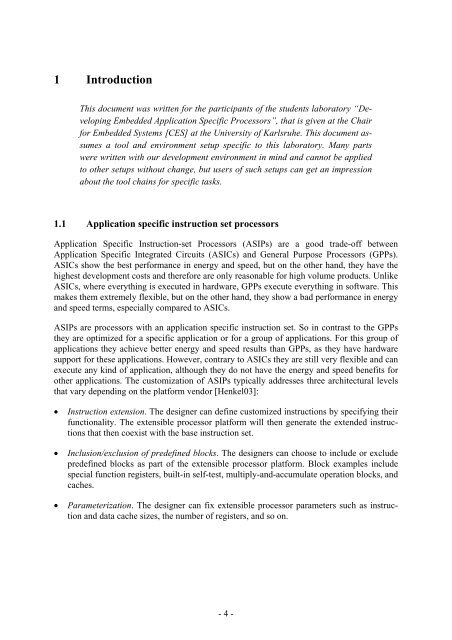Script for Laboratory: Designing embedded ASIPs - CES
Script for Laboratory: Designing embedded ASIPs - CES
Script for Laboratory: Designing embedded ASIPs - CES
Create successful ePaper yourself
Turn your PDF publications into a flip-book with our unique Google optimized e-Paper software.
1 Introduction<br />
This document was written <strong>for</strong> the participants of the students laboratory “Developing<br />
Embedded Application Specific Processors”, that is given at the Chair<br />
<strong>for</strong> Embedded Systems [<strong>CES</strong>] at the University of Karlsruhe. This document assumes<br />
a tool and environment setup specific to this laboratory. Many parts<br />
were written with our development environment in mind and cannot be applied<br />
to other setups without change, but users of such setups can get an impression<br />
about the tool chains <strong>for</strong> specific tasks.<br />
1.1 Application specific instruction set processors<br />
Application Specific Instruction-set Processors (<strong>ASIPs</strong>) are a good trade-off between<br />
Application Specific Integrated Circuits (ASICs) and General Purpose Processors (GPPs).<br />
ASICs show the best per<strong>for</strong>mance in energy and speed, but on the other hand, they have the<br />
highest development costs and there<strong>for</strong>e are only reasonable <strong>for</strong> high volume products. Unlike<br />
ASICs, where everything is executed in hardware, GPPs execute everything in software. This<br />
makes them extremely flexible, but on the other hand, they show a bad per<strong>for</strong>mance in energy<br />
and speed terms, especially compared to ASICs.<br />
<strong>ASIPs</strong> are processors with an application specific instruction set. So in contrast to the GPPs<br />
they are optimized <strong>for</strong> a specific application or <strong>for</strong> a group of applications. For this group of<br />
applications they achieve better energy and speed results than GPPs, as they have hardware<br />
support <strong>for</strong> these applications. However, contrary to ASICs they are still very flexible and can<br />
execute any kind of application, although they do not have the energy and speed benefits <strong>for</strong><br />
other applications. The customization of <strong>ASIPs</strong> typically addresses three architectural levels<br />
that vary depending on the plat<strong>for</strong>m vendor [Henkel03]:<br />
• Instruction extension. The designer can define customized instructions by specifying their<br />
functionality. The extensible processor plat<strong>for</strong>m will then generate the extended instructions<br />
that then coexist with the base instruction set.<br />
• Inclusion/exclusion of predefined blocks. The designers can choose to include or exclude<br />
predefined blocks as part of the extensible processor plat<strong>for</strong>m. Block examples include<br />
special function registers, built-in self-test, multiply-and-accumulate operation blocks, and<br />
caches.<br />
• Parameterization. The designer can fix extensible processor parameters such as instruction<br />
and data cache sizes, the number of registers, and so on.<br />
- 4 -
















